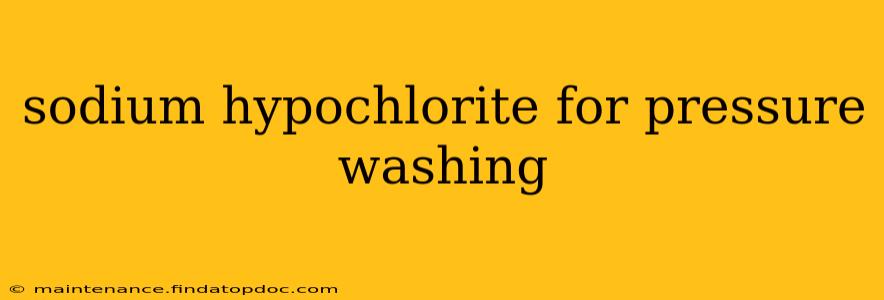Sodium hypochlorite, commonly known as bleach, is a powerful disinfectant often used in pressure washing applications. However, its use requires careful consideration due to its potent nature and potential safety hazards. This guide will explore the benefits, drawbacks, and best practices for using sodium hypochlorite in pressure washing.
What are the Benefits of Using Sodium Hypochlorite in Pressure Washing?
Sodium hypochlorite's primary benefit lies in its exceptional disinfecting capabilities. It effectively kills a wide range of microorganisms, including bacteria, viruses, and fungi, making it ideal for sanitizing surfaces where hygiene is paramount. This is particularly useful for cleaning areas prone to contamination, such as:
- Food processing plants: Eliminating bacteria and other pathogens is crucial in maintaining food safety standards.
- Hospitals and healthcare facilities: Sodium hypochlorite helps prevent the spread of infections.
- Public restrooms: Effective disinfection reduces the risk of spreading germs.
- Decks and patios: Removing mold and mildew is vital for preserving the beauty and integrity of these outdoor spaces.
What are the Drawbacks of Using Sodium Hypochlorite in Pressure Washing?
While effective, sodium hypochlorite also presents several drawbacks:
- Corrosiveness: It can damage certain materials, including metals and some plastics. Always test a small, inconspicuous area before applying it to the entire surface.
- Toxicity: It's crucial to wear appropriate safety gear, including gloves, eye protection, and respiratory protection, when handling concentrated sodium hypochlorite solutions. Proper ventilation is also essential to avoid inhaling fumes.
- Environmental Impact: Improper disposal can harm aquatic life. Always follow local regulations for disposal of bleach-containing wastewater.
- Color Degradation: Prolonged exposure can sometimes cause discoloration on certain materials, particularly fabrics.
- Reaction with other chemicals: Mixing sodium hypochlorite with other cleaning agents, especially acids, can create dangerous and toxic gases. Never mix bleach with ammonia or other cleaners.
How Do I Safely Dilute Sodium Hypochlorite for Pressure Washing?
The appropriate dilution depends on the application and the concentration of the bleach solution. Always refer to the product label for specific dilution instructions. Generally, a dilute solution is recommended for pressure washing; using too concentrated a solution increases the risk of damage and poses greater safety hazards. A common dilution is a 1:10 ratio (1 part bleach to 10 parts water), but this can vary significantly based on the task.
What Surfaces Can I Safely Clean with Sodium Hypochlorite?
While effective, sodium hypochlorite isn't suitable for all surfaces. Testing a small, inconspicuous area is crucial before widespread application. Suitable surfaces generally include concrete, brick, and some plastics; however, it's important to always check the manufacturer's recommendations for specific materials. Avoid using it on delicate materials like certain fabrics, polished wood, or painted surfaces that may be damaged by bleach.
What Safety Precautions Should I Take When Using Sodium Hypochlorite for Pressure Washing?
Safety should always be the top priority when using sodium hypochlorite. Here are some crucial precautions:
- Wear appropriate personal protective equipment (PPE): This includes gloves, eye protection, and a respirator, especially when working with concentrated solutions.
- Ensure adequate ventilation: Work in a well-ventilated area to minimize inhalation of fumes.
- Avoid contact with skin and eyes: In case of contact, immediately flush with plenty of water and seek medical attention if necessary.
- Store properly: Keep sodium hypochlorite in its original container, away from children and pets, in a cool, dry place.
- Dispose properly: Follow local regulations for the disposal of bleach-containing wastewater. Never pour bleach down the drain undiluted.
What are the Alternatives to Sodium Hypochlorite for Pressure Washing?
Several effective alternatives exist for pressure washing, depending on the specific needs:
- Other disinfectants: Various disinfectants, such as quaternary ammonium compounds, are available and may be more suitable for specific materials or applications.
- Pressure washing with plain water: For simple cleaning, high-pressure water alone can be surprisingly effective.
- Biodegradable cleaning solutions: Environmentally friendly options are increasingly available.
Using sodium hypochlorite for pressure washing requires caution and careful adherence to safety guidelines. While it offers powerful disinfecting capabilities, its corrosive and toxic nature mandates careful handling and proper disposal. Always prioritize safety and choose the cleaning solution best suited for the specific task and materials involved.
